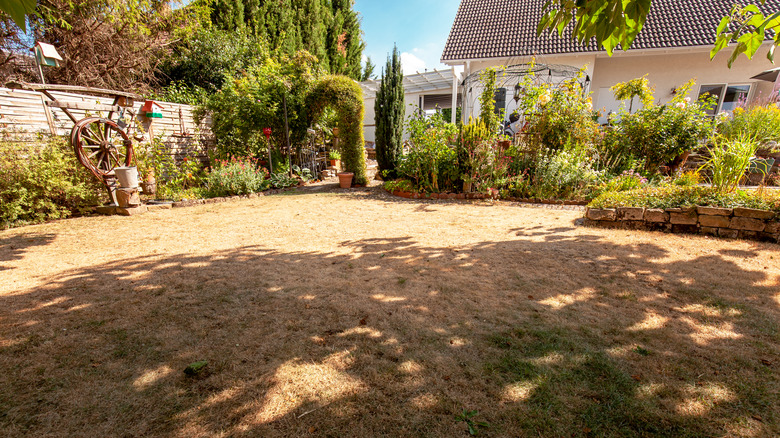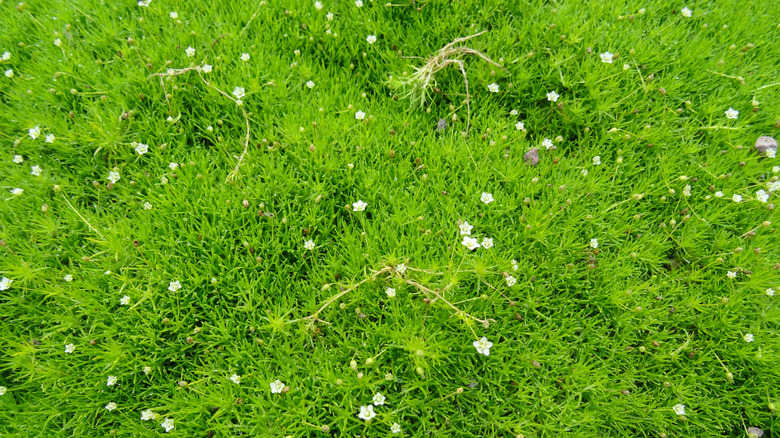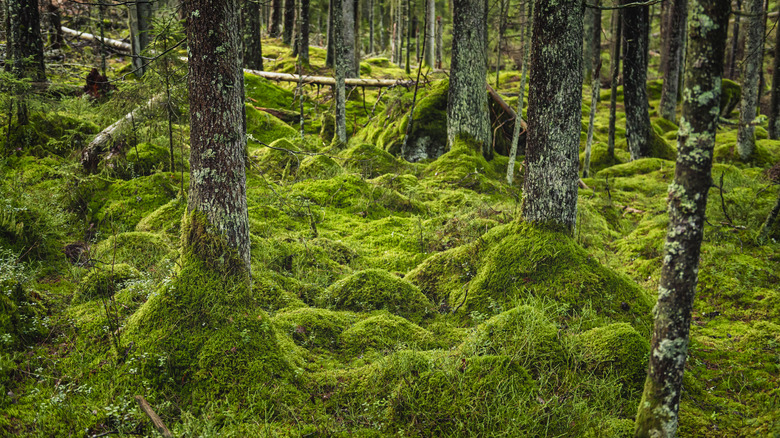Create A Lush Green Lawn That's Easy To Care For With This Great Grass Alternative
The lush suburban lawn is aesthetically pleasing, even if you prefer a more natural look. Achieving this green dream isn't always difficult, but it can be under certain conditions. If you find yourself with too much moisture on the lawn and see moss popping up, you should consider letting moss have the lawn. Yup, you can use moss as an alternative lawn plant. Moss isn't the answer for everyone since it can't handle foot traffic and needs to stay moist, but if it works for your situation, it looks as pretty as a freshly mowed grass lawn, and you don't even have to mow it.
Moss needs shade and moisture. If you can provide it with these things consistently, then it should be a nearly hassle-free choice for your lawn. However, if you live in a hot and arid climate, you'll find that it's a tough plant to keep happy. Do some research before you try to switch to moss. A good way to determine if moss will suit your yard is to see if it's already present. If you never see it around, you'll likely have a tough time growing it.
Green up your lawn with moss carpets
In the world of plant taxonomy, moss is below seed-bearing plants but more advanced than algae. It's certainly algae-like in appearance, but it looks grassy enough from afar to make it an aesthetically pleasing groundcover. If you're jumping into the world of mosses, you may want to try Thuidium delicatulum, or common fern moss. This moss ranges from light to dark green, forms thick mats, and is a bit tougher than other species.
Bryoandersonia illecebra is another good choice for lawns. Sometimes called worm moss, this species grows plump, cylindrical shoots. These shoots look like little blades of grass, and the plant spreads quickly, making it a good grass replacement. Another grass-like moss is Climacium americanum, called lobe-leaved tree moss or American tree moss. It's tall for moss species and has a beautiful grassy appearance that will look like a lush yard.
Irish and Scotch moss (Sagina subulata and Arenaria verna) are in the carnation family but give off mossy vibes. These plants produce small flowers, unlike moss, but they still grow low and compact, making them a good lawn alternative. Irish moss is deep green, while Scotch moss is a vibrant lime or chartreuse color.
Why moss is the boss
Moss may not be a good fit for your lawn if rambunctious pets or kiddos heavily use it. Since moss doesn't have roots anchoring it into the ground, it can easily be pulled up. In fact, it's so un-anchored that a leaf blower can remove dried-out moss. If you live in an area with strong winds, the moss may not stick around. That being said, if your lawn isn't walked on often, moss is a great option because, aside from watering, you don't have to do much to it. It won't need to be fertilized, and if your climate provides you with ample moisture, you may not even need to water it.
Many grasses don't grow in shady, wet areas, giving some lawns bare spots underneath large trees. This is where moss can save the day. Even if you don't want to fill your entire yard with moss, you can fill in the gaps with it. If moisture or shade kills your grass, try putting moss there to see how it goes. Moss will need to be watered more often in climates where it doesn't rain all the time, but you only need to water for about a minute or so to make the plants happy. Since moss stays short, you also don't have to worry about it growing out of control. It also encourages a diverse ecosystem by providing shelter for insects, which then feed larger critters like birds.


